Numpy Three Matrix Multiplication
Import numpy as np. Im figuring out the PythonC API for a more complex task.
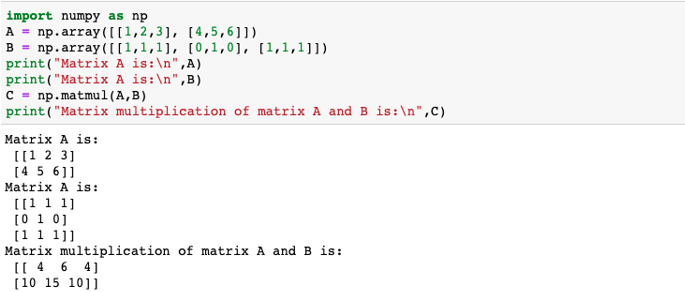
Matrix Multiplication In Numpy Different Types Of Matrix Multiplication
The build-in package NumPy is used for manipulation and array-processing.
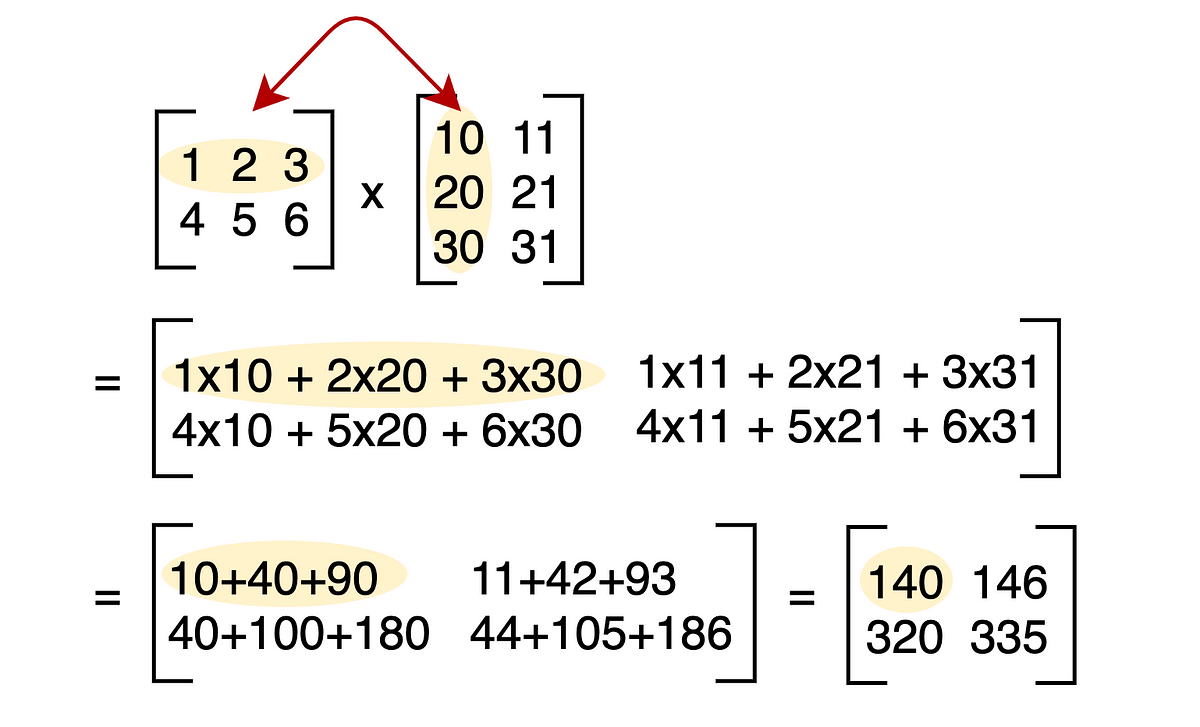
Numpy three matrix multiplication. To perform matrix multiplication of matrices a and b the number of columns in a must be equal to the number of rows in b otherwise we cannot perform matrix multiplication. Matrix multiplication of 2 square matrices. Mul_result nparraymat1nparraymat2 The above result will be of type array.
Second is the use of matmul function which performs the matrix product of two arrays. Matrix Multiplication in Python Using Numpy array Numpy makes the task more simple. Assume we have three matrices A_10x100 B_100x5 C_5x50.
The costs for the two different parenthesizations are as follows. If both arguments are 2-D they are multiplied like conventional matrices. We will use numpy arrays to represent matrices.
16 26 19 31 In Python numpydot method is used to calculate the dot product between two arrays. A core feature of matrix multiplication is that a matrix with dimension m x n can be multiplied by another with dimension n x p for some integers m n and p. Multiplication of two matrices by each other of size 33.
First is the use of multiply function which perform element-wise multiplication of the matrix. Import numpy as np m1 nparray123456789 m2 nparray987654332120 m3 npdotm1m2 printm3 Output. Import numpy as np A nparray3 6 7 5 -3 0 B nparray1 1 2 1 3 -3 C AdotB printC Output.
A nparray 123 456 B nparray 123 456 print Matrix A isnA print Matrix A isnB C npmultiply AB print Matrix multiplication of matrix A and B isnC The element-wise matrix multiplication of the given arrays is calculated in the following ways. Initially I wrote a simple example of adding two ndarrays of shape 23 and type float32. If you try this with its a ValueError This would work for matrix multiplication npones3 2 npones2 4.
If either argument is N-D N 2 it is treated as a stack of matrices residing in the last two indexes and broadcast accordingly. Let us now see how multiplication between a matrix and a vector takes place. I am able to pass two numpy arrays into c functions read their dimensions and data and perform custom addion on data.
To change it to the matrix you have to pass the result as an argument inside the matrix method. Mat1 npmatrix123456 mat2 npmatrix789101112 Matrix Multiplication. Dot ab_ ijkabc since it gives the dot product when a and b are vectors or the matrix multiplication when a and b are matrices As for matmul operation in numpy it consists of parts of dot result and it can be defined as matmul ab_ ijkc.
Numpymatmul numpymatmul a b outNone Matrix product of two arrays. Broadcasting a vector into a matrix. A miniature multiplication table.
Numpy Matrix multiply. Lets define a 5-dimensional vector and a 33 matrix using NumPy. 36 -12 -1 2 Transpose of a Matrix We use numpytranspose to compute transpose of a matrix.
Import numpy as np a nparray 1 3 5 7 9 b nparray 1 2 3 4 5 6 7 8 9 print Vector an a print print Matrix bn b Output. Because Numpy already contains a pre-built function to multiply two given parameter which is dot function we will encode the same example as mentioned above before it is highly recommended to see How to import libraries for deep learning model in python. We must check this condition otherwise we will face runtime error.
5 12 21 32 The below image shows the multiplication operation performed to get the result matrix. Import numpy as np arr1 nparray 1 2 3 4 arr2 nparray 5 6 7 8 arr_result npmultiply arr1 arr2 print arr_result Output. These are three methods through which we can perform numpy matrix multiplication.
Cost AB C 10 100 5 10 5 50 5000 2500 7500 cost A BC 10 100 50 100 5 50 50000 25000 75000. In this example we multiply a one-dimensional vector V of size 31 and the transposed version of it which is of size 13 and get back a 33 matrix which is the outer product of VIf you still find this confusing the next illustration breaks down the process into 2 steps making it clearer. 25 19 19 12 73 58 55 39 121 97 91 66 We first created the matrices in the form of 2D arrays with the nparray method.
Npmatrixmul_result The output of the above code is below. A 1 2 2 3 B 4 5 6 7 So AB 14 26 24 36 15 27 25 37 So the computed answer will be. Matrix multiplication is an operation that takes two matrices as input and produces single matrix by multiplying rows of the first matrix to the column of the second matrixIn matrix multiplication make sure that the number of rows of the first matrix should be equal to the number of columns of the second matrix.
The behavior depends on the arguments in the following way.
Numpy Matrix Multiplication Numpy V1 17 Manual Updated
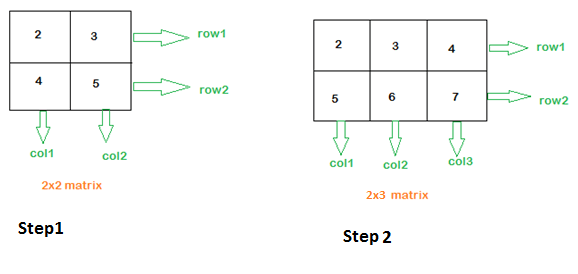
Python Matrix Transpose Multiplication Numpy Arrays Examples
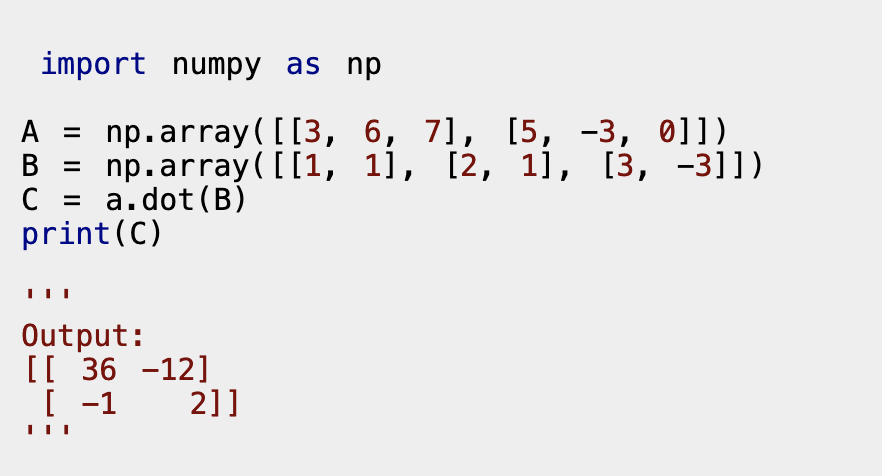
Numpy Matrix Multiplication Numpy V1 17 Manual Updated

Numpy Matrix Multiplication Journaldev

20 Examples For Numpy Matrix Multiplication Like Geeks

Numpy Matrix Multiplication Studytonight

A Complete Beginners Guide To Matrix Multiplication For Data Science With Python Numpy By Chris The Data Guy Towards Data Science
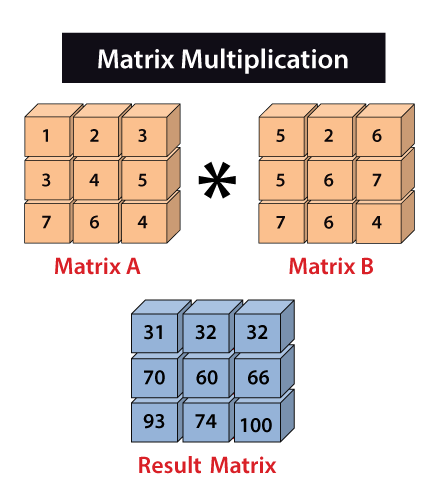
Numpy Matrix Multiplication Javatpoint

Numpy 3d Matrix Multiplication Geeksforgeeks

Numpy Matrix Multiplication Np Matmul And Ultimate Guide Finxter
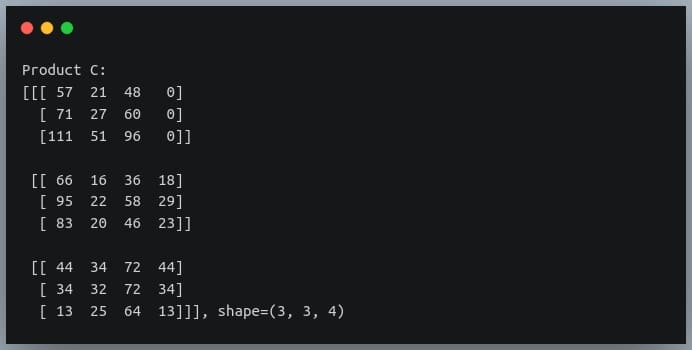
20 Examples For Numpy Matrix Multiplication Like Geeks

Numpy Matrix Multiplication Journaldev
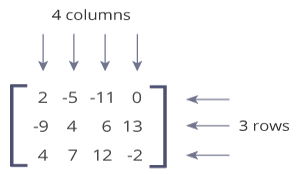
Python Matrix And Introduction To Numpy

Numpy Matrix Multiplication Journaldev
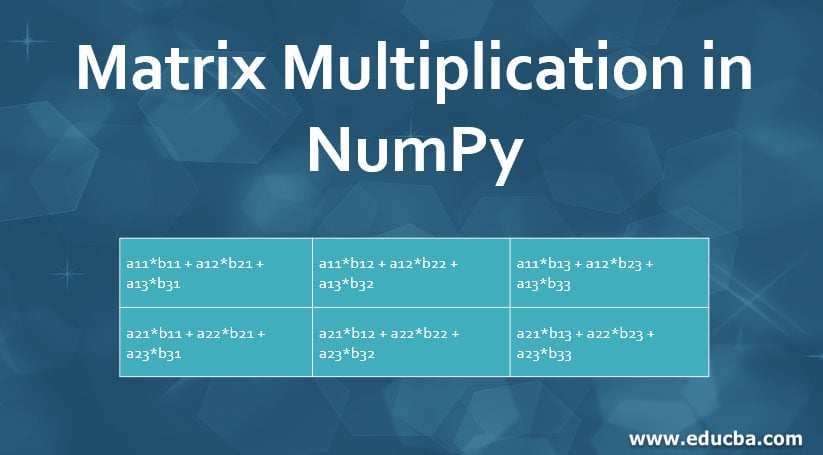
Matrix Multiplication In Numpy Different Types Of Matrix Multiplication
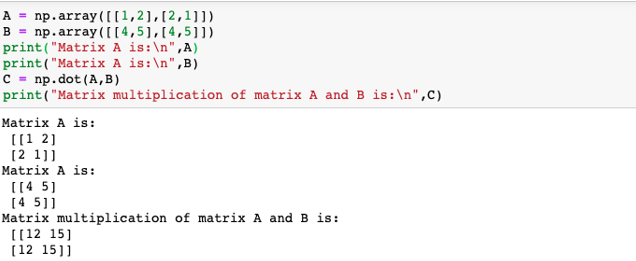
Matrix Multiplication In Numpy Different Types Of Matrix Multiplication
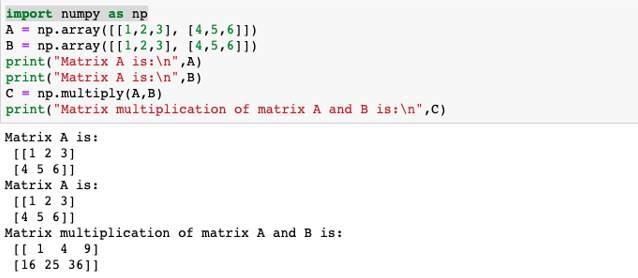
Matrix Multiplication In Numpy Different Types Of Matrix Multiplication
Numpy 3d Matrix Multiplication Geeksforgeeks
Numpy Matrix Multiplication Tutorial Coding Ninjas Blog
